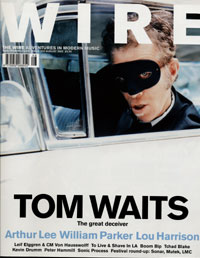| Jonah Brucker-Cohen – NY Streets Yeah! 2007 | Google Geek Street Fair, gadgITERATION, July 31, 2013 |
EMAIL MILES Press Mentions
- BGR
- News India
- NDTV
- Colorado News Day
- BBB News
- Daily Mail Online:
- NY Post
- Think Digit
- Hindu Times
- GeoSpatial World
- Pure 360
- India News
- EFY Times
- TechniCaly
- Huffington Post
- EAC Directory
- You’ve got mail, now look how far it has travelled, The Times, February 18, 2014.
- Emails Angels
- Buzz Latest
- Paper Blog
PrintCade on The Creators Project, These Old School Hackers Used Dead Tech To Make Arcade Game Art, Febraury 10, 2014.
StockBank on HackaDay Blog, This Piggy Bank is Our Stock Broker, April 20, 2013.
StockBank on Reddit: StockBank, an Arduino piggy bank that buys stocks when it has enough coins. How to build inside., April 11, 2013.
StockBank on Adafruit Blog:StockBank – A Networked Piggy Bank , April 11, 2013.
Jonah Brucker-cohen on the Discovery Channel talking about Ubiquitous Computing in relation to the Play-A-Grill project by Aisen Caro Chacin Future Tech – Play-A-Gril, Discovery Channel: Future Tech, February 2013.
Jonah Brucker-cohen: New Media, From Web 2.0 To Web 4.0, By Donata Marletta, DIGIMAG.
“#A.I.L – artists in laboratories, episode 4“, We Make Money Not Art, June 11, 2012.
“Recycled Art Hits the Streets“, Banff Cragg and Canyon, by Corrie DiManno, July 13, 2011.
COLORBOTS TAKE OVER PARSONS BLOCK PARTY! ,Sparked, by Christopher Musci, May 22, 2011.
New Media engages Baruch students in the Scrapyard Challenge ,The Ticker, Baruch College Newspaper, Sabrina Khan, May 10, 2011.
Jonah Brucker-Cohen: Interactive Networked Projects 1996-2010 , Beyond The Beyond, Bruce Sterling, August 28, 2010.
Students turn “one man’s junk” robots , pictures from the workshop, Connecticut College Current: by Amy Martin, March 5, 2010.
JONAH BRUCKER-COHEN INTERVIEW , Vague Terrain: by Joshua Noble, February 1, 2010.
JONAH BRUCKER-COHEN: NEW MEDIA, FROM WEB 2.0 TO WEB 4.0 , DigiMag: by Donata Marletta , January 2010.
Help Jonah Destroy the Art Museum , Beyond The Beyond, Bruce Sterling, August 30, 2009.
“ReFunct”, Lecool Magazine, August 20-26, 2009.
“Interview with Jonah Brucker-Cohen”, interviewed by Andrea Polli at Futuresonic 2009 on May 16, 2009.
“Interview with Jonah Brucker-Cohen”, aMinima Magazine, 2003.
“Interview with Jonah Brucker-Cohen”, El videojuego de la vida, March 5, 2009.
“Desenredando technologies: a desconstrutor (humorous) of fixed networks, mobile, public and private”, interview in Art.Mov, Belo Horizonte, Brazil, 2008.
WiFi liberation and spam-victim Casting, Interview with ORF.at, Austrian Press, Sept 13, 2008.
Google Alert Loop Rhizome.org, 2/29/2008
GPS-HOG Tactical Coordinate Suppression, Make, 9.11.07
Nerdblog, 9.12.07. PleaseSpam.Us PleaseSpam.US, serving spam as a revenge., Neural, 3/4/08.
PleaseSpam.Us – Collaborative voting for spam-worthy addresses,DIGG, 9/3/07.
“The “Law of the Number” Polarizes The Opinions of the Internet“, Ecrans (La Liberation), (Translated from French) France, August 1, 2007. (Original French version here)
Revenge is a Dish Best Served By Email: How To Get Someone Spammed to Death, Art Threat, 11/23/2007.
Mr.T1 “Open-source Bandwidth Speed-Tracker: The Truth of Connectivity Finally Revealed“, Art Threat, July 19, 2007
MAKE Blog, July 16, 2007.
CrunchGear, “Pretty Much The Greatest Application Ever”, July 16, 2007.
DIGG, July 16, 2007.
Science Buzz, “Mr.T Tells it Like it is”, July 17, 2007.
Nerd Arts, July 17, 2007.
“In the Laboratories of Art”, El Pais, 4.7.2007(PDF)
Forward Compatible Make Blog, 2.19.2007
Engadget, 2.19.2007
Digg, 2.19.2007
Wifi-Liberator WiFi Liberator Unchains the Masses from Paid WiFi, Crunch Gear, 2/5/07.
WiFi Liberator Ends Tyranny of Pay-Per-Use Wireless, Gizmodo, 2/2/07.
WiFi Liberator Toolkit, We-Make-Money-Not-Art, 2/2/07.
WiFi Liberator beams pay-per-use access to others gratis, Engadget, 2/4/07.
Share closed WiFi with the Wifi Liberator, Boing Boing, 2/3/07.
Wifi Liberator ToolKit, Digg, 2/2/07.
Wifi Liberator, Make Blog, 2/3/07.
Wifi Liberator, Hack Zine, 2/3/07.
“Tinker and tweak: interview with Jonah Brucker-Cohen and Katherine Moriwaki“, August 1, 2006, (Originally published by the Virtual Platform in August 2006).
IPO Madness mentioned in Wired News for the Artbots NYC Regional Show 11/12/06.
mentioned in Make Blog for the Artbots NYC Regional Show 11/10/06.
Interview With Jonah Brucker-Cohen We-Make-Money-Not-Art by Regine DeBatty, 9/10/06.
Rhizome News The Art of Networks by Michelle Kasprzak, 9/8/06.
Interview With Jonah Brucker-Cohen: “Meet Jonah Brucker-Cohen From Coin-Operated.Com”, Part 1, Part 2 by Amy Bowllan, School Library Journal, 6/7/06.
Articles about SimpleTEXT:
“Personal Tech Is Almost a Party”, by Rachel Metz, Wired News, 11/7/05.
“Tech Brings Throngs Together”, by Shayne Barr, Washington Square News, 10/28/05.
“Art Unfolds in a Search for Keywords”, by Matthew Mirapaul, The New York Times: Circuits, 6/17/04.
Article on SimpleTEXT and Wifi-Hog: “State of the Artists”, by David Pescovitz, TheFeature.com (cached), 4/22/04.
BumpNet Articles:
“BumpNet social experimentation through frustration”, Engadget, 6/18/05.
“A Wireless Network for the Determined”, WMMNA, 6/16/05. “A Wireless Network for the Determined”, Networked Performance, 6/16/05.
Articles / Stories on UMBRELLA.net:
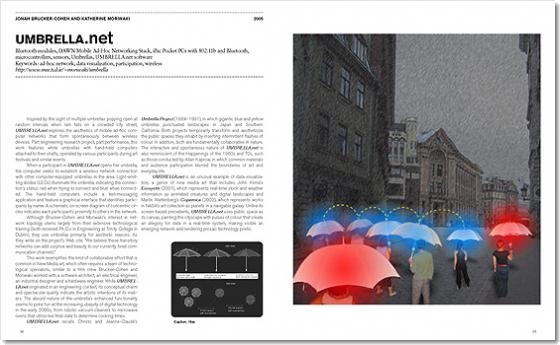 Tribe, Mark, Jana, Reena. “Art in the Age of Digital Communication”, New Media Art, (Book) Taschen, USA, 2006.
Tribe, Mark, Jana, Reena. “Art in the Age of Digital Communication”, New Media Art, (Book) Taschen, USA, 2006.
Spaced Out Artists Create Way-out Worlds, The Age, Melbourne, Jenny Sinclair, 10/5/05
Mit Schirm, Charme und Bluetooth, News Frankfurt, By Nina Bublitz, 9/20/04
Irish take cover under Bluetooth umbrella, The Register, By Jan Libbenga, 9/2/04
Umbrellas in the Mesh – Unstrung.org – Tied to Nothing but the Future, By Dan Jones, 8/12/04
Bluetooth Umbrella Networks – Gizmodo.com, 8/12/04
In the Forecast — Art, Research, and Rainstorms – Rhizome.org – Net Art News, By Ryan Griffis, 3/1/04
Status Play/ Public Desktop Articles: Keep Track of What App He is Using – Rhizome.org – Net Art News, By Karen Kuslansky, 2/6/04
PublicDesktop, la scrivania come strumento di comunicazione. – Neural.it, 2/6/04
InternetRadio: CyberSonica 2002 Review, by Lina Dzuverovic Russell, The WIRE, Issue 222, 8/2002. (PDF – 4MB)
WiFi-Hog Articles:
“Wi-Fi Hog, prendere il controllo di una rete wireless”, Neural.it, 9/18/03.
The Works of Jonah Brucker-Cohen by Dyske Suematsu – August 27,2003.
Excerpt from Bumpy Ride, The New York Times: Circuits Section, By Pamela Licalzi O’Connell, 7/31/03 about BumpList:
Download: PDF (600k)
“Among the thousands of e-mail based discussion groups, many are private and clublike, while others are public and raucous. But there’s nothing else quite like BumpList (www.bumplist.net). BumpList, a discussion forum with no defined topic, allows just six subscribers at a time. When a new person joins, a subscriber is bumped off to make room. To rejoin you must resubscribe, bumping someone else, and so on. To stay on the list for any significant time requires numerous resubscriptions – the list calls itself “an e-mail community for the determined.” So far, more than 1,700 people have joined at least once and there have been 1,300 resubscriptions. (I lasted just 10 hours and 25 minutes before my first bump.) BumpList is a sort of art project as behavioral experiment. “I want to get people to think about the culture and process of these lists,” said Jonah Brucker-Cohen, the site’s creator and a researcher in the Human Connectedness Group at Media Lab Europe, an institute in Dublin. For example, the structure of BumpList prevents cliques from forming, making it more “democratic” than most lists, he said. ”
BumpList Articles: NetArtReview – By Eduardo Navas, 6/4/03
Bump The List! – Rhizome.org – Net Art News, By Valerie Lamontagne, 6/13/03
An Experience in Social Computation, – Sapo.Pt, Portugal Online!, 6/6/03.
[English] Mladina (Slovenian Magazine) – By Jaka Zeleznikar, 6/28/03
BumpList, una mailing list in coda FIFO. from Neural online, 7/3/03.
[English] LockerGnome WindowsDaily – By Cheerleader Meryl, 7/28/03
Bumpy Ride, The New York Times: Circuits Section, By Pamela Licalzi O’Connell, 7/31/03.
Excerpt from “New exhibit opens in the Digital Hub” about Phonetic Faces by Matthew Clark, 4/1/03, ElectricNews.net:
“One piece in Exhibit 2 is by Jonah Brucker-Cohen, entitled Phonetic Faces, which creates art by merging several digital images together. The exhibit consists of a large screen positioned below a digital camera that, when commanded via a mobile phone, will capture images of onlookers. Images, which have a ghost-like quality, are combined with other photos or are altered by spectators, forming a collage that in some instances takes the shape of a strange inhuman face. It is envisioned that Phonetic Faces could be used in public places such as train and bus stations for the enjoyment of travellers. The voice-based system that users interact with employs what is known as VoiceXML, a type of software provided by Dublin-based Voxpilot that can recognise speech.”
Excerpt from Netartreview.net on “Desktop Subversibles” by Eduardo Navas – March 24,2003: ‘
“Turbulence.org has released its last feature for the year 2003 — a spotlight on Jonah Brucker-Cohen. The emphasis is on Cohen’s new media work dealing with the now naturalized desktop activities of “copy and paste” and simple “mouse movements.” Brucker-Cohen considers these activities important metaphors and reinterprets them in Desktop Subversibles to make people aware of mundane activities. His interfaces are intricately designed to push users into a reflective critical interactive state.”
Desktop Subversibles Articles:
Irish Examiner – “Household goods furnished with technology of the future”, Human Connectedness Group article, 5/30/03, (PDF – 2.5 MB)
Liberation (France): “Des souris et un homme” (Mice and Men) by Marie Lechner – 4/25/03 – (English Translation)
Portugal Online!: Computer Interaction – 3/20/03 – (English Translation)
Medienturm: DS Article – 3/14/03 – (English Translation)
Rhizome.org: Contribute to a Global Movement – 3/7/03
PoliceState from Studio Voice magazine (Japan)- vol. 328, April 2003:
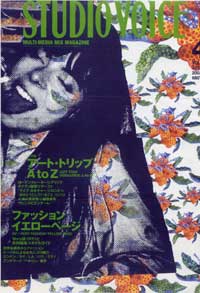 |
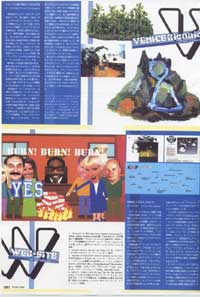 |
Studio Voice Article (low rez version – pdf 68k) Studio Voice Article (hi rez version – pdf 5 MB) PoliceState featured in Dutch Press for DEAF03 Festival 2/25/03: 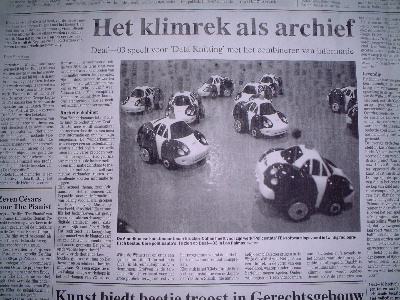 From Neural.it (Italy): Desktop Subversibles: The Mouse Awareness – 4/3/03 (English Translation)
From Neural.it (Italy): Desktop Subversibles: The Mouse Awareness – 4/3/03 (English Translation)
From Toster.ru (Russia): No Art in Iron by D.K. – 1/17/03 (English Translation)
From Rhizome.org: Interview with Jonah Brucker-Cohen by August Highland – 1/16/03
StreamingMedia (H20/IP) articles: Streaming audio using water (and other radio hacks) , The Guardian, By Andrew Orlowski, 12/9/03.
Daten via Wasser Ÿbertragen – from Der Standard (Austria) (German version only) – 5/2/03
El ‘ciberartista’ Brucker-Cohen consigue transmitir imagenes entre ordenadores a traves del agua – from El Pais – 2/20/03(English)
StreamingMedia: electronic art with IP and water from Neural.it – 1/4/03
Water Way To Run a Network – from vnunet.com – 1/3/03
Quand l’eau sert de reseau – from TF1 – 1/5/03 H20/IP – from Slashdot.org – 1/30/02
ClipIt! article: ClipIt!, to share the ‘ copy and paste’ with the rest of the net. – from Neural.it – 5/10/02 (English Translation)
Excerpt from Neural.it on “StreamingMedia (H2O/IP)” Italy, 2003: “StreamingMedia is defined by its author Jonah Brucker-Cohen as an ‘interactive data sculpture’ which implements the H2O/IP protocol, that is, the transmission of informations between two computers by means of water.
The innovative installation consists of two computer put at different heights, one of which captures an image and sends it to the other using a code made of water drops. The project aims to demonstrate how digital informations can be encoded and decoded using organic forms, so as to create a physical network between different devices. The characteristics of the single data packet are much more than the usual, and they include: fluidity, heat, properties of the three states of the matter (solid, liquid, gaseous), varying density according to state and surface tension. The system conforms to the OSI (Open Systems Interconnection) standards for the physical, network, transport and application layers. If the mix of organic and digital is always fascinating, since it allows to regain familiarity with the machine and rationalizes the natural according to binary parameters, this work liquefies the data packets giving them back the physicalness they lacked. The data become therefore visible, and their abstraction becomes material through, paradoxically, the oldest medium for transporting informations: water.”
Excerpt from Transmediale.02 catalog on “Crank The Web” Berlin, Germany, 2002: “The idea behind Crank the Web is to connect old-fashioned forms of automatisation with the new, digital telecommunication technology. The combination of such a simple and well-known tool as the crank with contemporary technology is an effort to make hidden or usually unrecognised computer actions more transparent. Brucker-Cohen’s work Crank the Web uses a very direct language actually in tune with the practice-oriented design-approach used by the MIT (Massachusetts Institute of Technology), the European branch institute of which Brucker-Cohen currently works and researches for. But already before his work for the MIT Brucker-Cohen had begun with translating regular, graphicsbased interfaces into physical interfaces. Maybe it is exactly this no-nonsense clarity and selfcontentedness of this work which renders it so accesible, maybe also getting in the way of the inherent reflection on the global differences in access to this new technological equipment and a speedy internet connection. Brucker turns the demand for free and unlimited access for everybody into an object relating the individually available bandwidth with physical strength as opposed to personal wealth.”
Excerpt from Interface Explorer Conference site on “Physical Web Interfaces“, Vienna, Austria, 2001: “Physical Web Browsers is a series that makes visible the material or “labor” character of processes that we have learned to regard as purely virtual, thus adding a socio-critical dimension to the interaction of man and machine when they meet at the interface.”
Excerpt from “Crack the Code: Design and Deliver!” by Jennifer Min, 2001: “The Grand Prize Winner, Brucker-Cohen demonstrated his “Crank the Web” to shouting and applause from the eager, excited audience as he feverishly turned the crank and NYU’s website slowly began loading. Analog information in the form of a hand crank is used to control bandwidth rates and content delivery of digital information through the internet. “It places the power of delivery in your own hands. The rate at which you turn the crank is the rate of your download speed. This way you can’t ever complain that download speeds are too slow,” Brucker-Cohen said. “And everyone should be given unlimited bandwidth for free.” Although “Crank the Web” was not a browser interface, it just goes to show you that creative ingenuity goes a long way.”
Excerpt from Hvedekorn Magazine online: Creative Computer Science: An Intro to Jonah Brucker-Cohen by Andreas Brogger, 2001 Brucker-Cohen is a native in our digital world, having worked – despite his young age – in nearly any sector of the computer and computer-related industry already: as a game designer, programmer, engineer, writer, artist. So, we might ask, is he an artist working as a research fellow in digital technology? Or is he a computer scientist experimenting with aesthetic issues? Recycling digital culture and related issues at his website Coin-operated, and writing on digital culture for magazines like Wired, ID Magazine, Print Magazine, Edesign, and Time Out New York, Jonah Brucker-Cohen could also be described as a critic and commentator on these very same fields of expertise. His activities are cross platform in more than a literal sense. And so should perhaps our concept be of what an artist, an engineer, a computer scientist, and a writer is at this point in the history of (digital) art?
Excerpt from NY Times Article: Arts Online: Innovative Webmasters Chase Fame at Browserday by Matthew Mirapaul, April 2, 2001 or Cached version (.html) Jonah Brucker-Cohen doesn’t surf the Net so much as he takes it for a spin. To visit a Web site, he types its address and watches as a blank page pops up on his monitor. Then he grabs the handle of a device connected to his computer and cranks it furiously, as if he were revving up a Model T. The more quickly he rotates the handle, the faster the page appears digitally on the screen. The system’s benefits are that “you control your own bandwidth,” Mr. Brucker-Cohen explained, referring to the size of the data-delivery pipeline, “and it increases your fitness.” Mr. Brucker-Cohen, an artist and a research fellow at New York University, demonstrated his Crank the Web project on Thursday during International Browserday, a design competition whose finals were held at Cooper Union in the East Village. Browserday allows college students to illustrate their visions of how people will interact with the Internet as it evolves. Although no one expects Mr. Brucker-Cohen’s prototype to become a real product, it was clearly the crowd favorite and earned its maker the contest’s top prize, a laptop computer that does not require bulging biceps to access the Internet.
Excerpt from IEEE Spectrum Article: Electronic Realism by Stephen Cass, Associate Editor, March, 2001
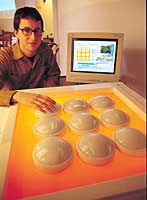 Scan of the article:
Scan of the article: 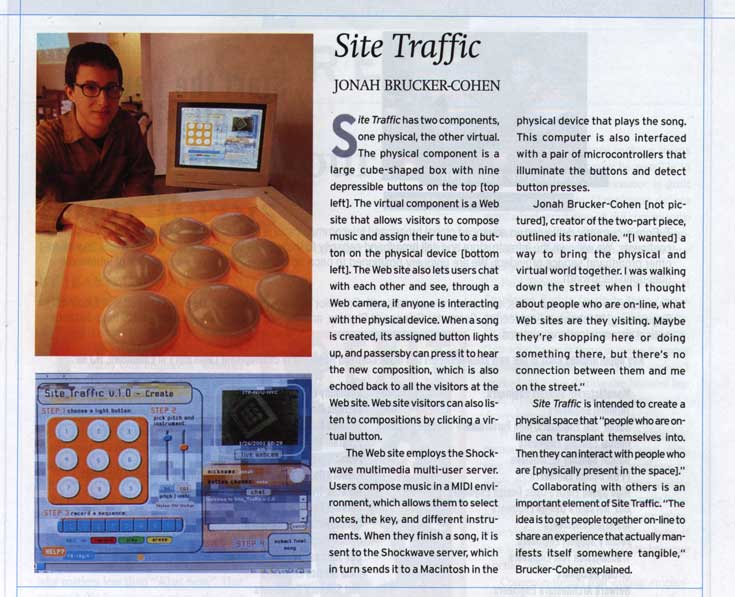 Site Traffic has two components, one physical, the other virtual. The physical component is a large cube-shaped box with nine depressible buttons on the top [top right]. The virtual component is a Web site that allows visitors to compose music and assign their tune to a button on the physical device [bottom left]. The Web site also lets users chat with each other and see, through a Web camera, if anyone is interacting with the physical device. When a song is created, its assigned button lights up, and passersby can press it to hear the new composition, which is also echoed back to all the visitors at the Web site. Web site visitors can also listen to compositions by clicking a virtual button. The Web site employs the Shockwave multimedia multi-user server. Users compose music in a MIDI environment, which allows them to select notes, the key, and different instruments. When they finish a song, it is sent to the Shockwave server, which in turn sends it to a Macintosh in the physical device that plays the song. This computer is also interfaced with a pair of microcontrollers that illuminate the buttons and detect button presses. Jonah Brucker-Cohen, creator of the two-part piece, outlined its rationale. “[I wanted] a way to bring the physical and virtual world together. I was walking down the street when I thought about people who are on-line, what Web sites are they visiting. Maybe they’re shopping here or doing something there, but there’s no connection between them and me on the street.” Site Traffic is intended to create a physical space that “people who are on-line can transplant themselves into. Then they can interact with people who are [physically present in the space].” Collaborating with others is an important element of Site Traffic. “The idea is to get people together on-line to share an experience that actually manifests itself somewhere tangible,” Brucker-Cohen explained.
Site Traffic has two components, one physical, the other virtual. The physical component is a large cube-shaped box with nine depressible buttons on the top [top right]. The virtual component is a Web site that allows visitors to compose music and assign their tune to a button on the physical device [bottom left]. The Web site also lets users chat with each other and see, through a Web camera, if anyone is interacting with the physical device. When a song is created, its assigned button lights up, and passersby can press it to hear the new composition, which is also echoed back to all the visitors at the Web site. Web site visitors can also listen to compositions by clicking a virtual button. The Web site employs the Shockwave multimedia multi-user server. Users compose music in a MIDI environment, which allows them to select notes, the key, and different instruments. When they finish a song, it is sent to the Shockwave server, which in turn sends it to a Macintosh in the physical device that plays the song. This computer is also interfaced with a pair of microcontrollers that illuminate the buttons and detect button presses. Jonah Brucker-Cohen, creator of the two-part piece, outlined its rationale. “[I wanted] a way to bring the physical and virtual world together. I was walking down the street when I thought about people who are on-line, what Web sites are they visiting. Maybe they’re shopping here or doing something there, but there’s no connection between them and me on the street.” Site Traffic is intended to create a physical space that “people who are on-line can transplant themselves into. Then they can interact with people who are [physically present in the space].” Collaborating with others is an important element of Site Traffic. “The idea is to get people together on-line to share an experience that actually manifests itself somewhere tangible,” Brucker-Cohen explained.
Excerpt from Village Voice Article: Royal Paeans in the Ass by Chris Barton, May 3, 2000 Last of the Great 20th Century Composers is also enhanced with, believe it or not, four cleverly silly Atari-like video games. Designed by Jonah Brucker-Cohen, the suite of games, entitled “How to Be a Superstar,” begins abruptly with an image of Concetta’s face, accompanied by her shouting “I RULE!” The Princess parodies Lara Croft, dissing sucka MCs left and right. Another game features her head as a spaceship in an Asteroids-style challenge, in which space rocks are shaped like major label logos. One game even lets players (not to be confused with player-haters) plan out a dance routine for the Princess.
Excerpt from SHIFT Japan: THE 8TH NEW YORK DIGITAL SALON by Michael Foronda, 2000 Jonah Brucker-Cohen’s “IPO Madness” probably brought more attention onto itself then any other piece in the show but managed to live up to that billing. Disguised as a slot machine, the piece incorporated a browser that both generated random IPO addresses and shouted out WHASSUP (ala Budweiser Boys) with every pull of the lever. Even the interface with its inundation of banner ads was consistent with the visual vocabulary of lowbrow Las Vegas. The Jackpot was hit when you landed on an operating URL and was accompanied with the Slim Shady anthem.
Excerpt from MediaChannel.org Article: Browser Ware by Robert Atkins, Sept 10, 2001 Jonah Brucker-Cohen’s first-prize winning “Crank the Web,” which hilariously “solves” the problem of bandwidth inequity by awarding the widest bandwidth to the physically, rather than economically, fit. The user types a Web address into a commercial browser and then cranks up the bandwidth by vigorously turning the handle of a re-purposed boat winch attached to the computer. (What about a stationery bike interface to make browsing a truly healthful experience?)
Excerpt from Browserwatch Article: Special Report: International Browserday Finalists Announced by Brian Proffitt , March 30, 2001 And the Grand Prize Winner for the International Browserday event was Jonah Brucker-Cohen, New York University, New York, with his uniquely titled Crank The Web, which uses analog automation in the form of a hand crank to control bandwidth rates and content delivery of digital information through the Internet.
![]()




